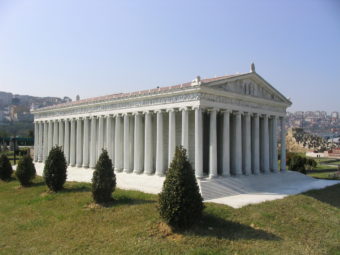The Dude Who Burned Down the Greatest of the Seven Wonders of the Ancient World Because of Reasons
*Note: This is still a little out of order, as we are needing to further delay publishing of the Tech History Part 3 owing to, ironically enough, technical difficulties. We’ll have it up within the week most likely though.
 In this episode of The Brain Food Show, we start by looking at what literal battleships had to do with the creation of the Slinky.
In this episode of The Brain Food Show, we start by looking at what literal battleships had to do with the creation of the Slinky.
Next up, we jump into the main part of the show looking at what is largely considered the greatest of the so-called Seven Wonders of the Ancient World, and then look at the guy who burned it down just so history would remember him, as well as what steps the ancients took to try to stop him from achieving that goal.
On another note, if you could do us a huge favor and rate and review this show in whatever podcasting platform you’re using (including hopefully giving us some feedback related to the new format), we would be extremely grateful. If you prefer, you can also email us at [email protected]. Thanks!
(You can also discuss this episode and view references on The BrainFood Show forum here.)
Don’t miss future episodes of this podcast, subscribe here: iTunes | Spotify | Google Play Music | Stitcher | RSS/XML
You can also find more episodes by going here: The BrainFood Show
Podcast (brainfood): Play in new window | Download (Duration: 51:15 — 70.4MB) | Embed
Subscribe: Apple Podcasts | Android | Google Podcasts | Stitcher | RSS
| Share the Knowledge! |
|





Cats slink, sexy slim women have a slinky walk. You are welcome.
I really wish you would provide a transcript to the podcasts you do. I don’t “do” podcasts and would rather read an article than listen to people talk about it.
Just my 2 cents
I agree with MadMonk. I know that the PodCast would need to be edited to a readable format, but I think you could get two or three readable articles from each PodCast.
Same here. Turn a two or three minute article into a long podcast doesn’t help, not to mention I am seldom where I can listen to a podcast anyway.
I’ve seen many interesting titles go by, but they’re basically not accessible to me.
Why hasn’t an episode been uploaded to Google play since September 30th?
It’s updating OK when I look at it on Google play. Might just be something weird on your phone or something. I’d try deleting and re-adding the feed or something. Sort of the “reset button” for podcasts. 😉
G’day simon i really like ur podcast
Simon and Daven
You were wondering if soft ground helps buildings resist earthquakes and the short answer is yes (with a big BUT for swamps).
When an earthquake occurs the shaking travels from the epicentre out mostly through the rock in the earths crust.
To affect a building this energy has to get from the deep rock up to the surface to affect the building.
If it is rock all the way to the surface the shaking action is transferred very efficiently so the building is shaken very hard.
If however the ground is softer it acts as a damper and is less efficient at transferring the earthquakes energy.
Now for the BUT.
When an earthquake travels through ground that is saturated an affect known as liquefaction can occur. This is where the shaking for soil saturated soil partials can effectively cause the whole ground to act as a liquid.
Heavy buildings prefer solids to liquids for their foundation so if the ground suddenly starts acting like a liquid they tend to sink or fall over.
Some of the prep work to the ground you described could help reduce the chances of liquefaction as it generally occurs where the ground is insufficiently compacted thus leaving enough space for the soil particles to ‘jiggle’ around.
Thanks for the great podcast
Tap
Structural Engineer
Structural and Civil Engineers are the people you’re thinking of who design structures according to codes and necessary safety precautions- including soil types, floodplains, fault lines, and other potential geological hazards. Architects are great, but generally speaking only concern themselves with the aesthetic design of a building. Structural and Civil Engineers are the backbone of taking those designs and then actually making them WORK.
Hey so really interesting thought about motive for burning down the temple. I know he didn’t want to be forgotten, because it’s what you guys said. Actually an ancient Roman religion when you went to hell with everyone. It actually in ancient Roman religion when you went to hell with everyone did it was not considered a bad place; you got to chill out in the afterlife until the last person remaining on earth forgot your name then you truly just disappeared